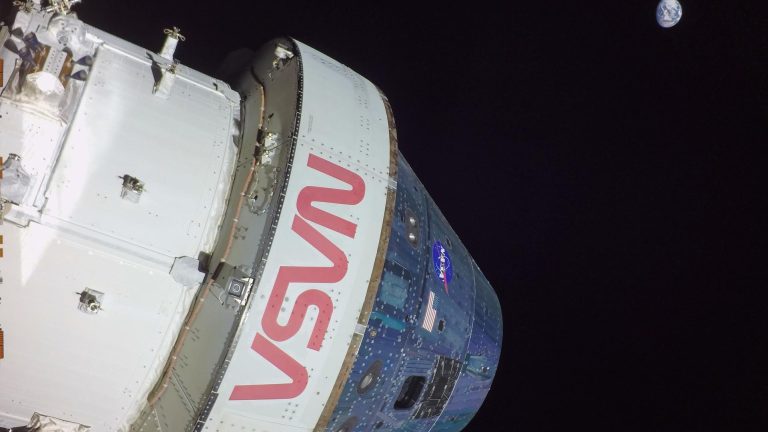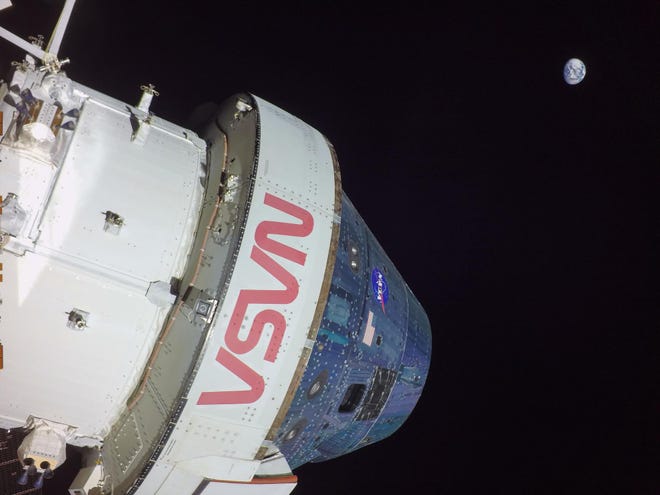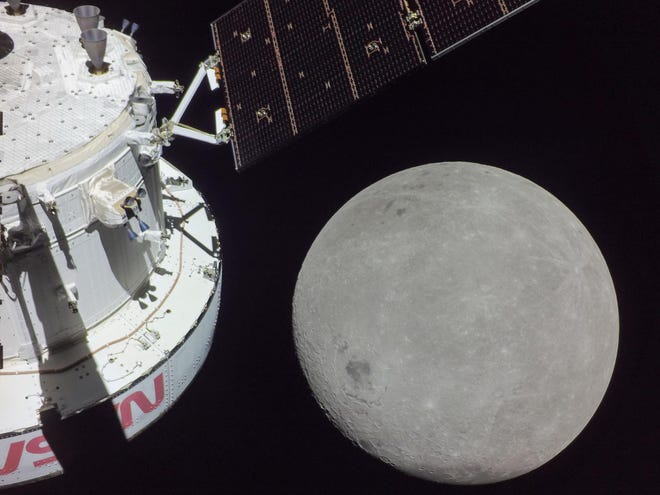
NASA’s Artemis I Orion cspanpsule broke records this past week as it continued to push further away from the Earth and moon.
Over the weekend, the uncrewed Orion broke the record of set by Apollo 13 in 1970 for the farthest a human-rated spacecraft had ever been from Earth as it sailed past 250,000 away.
On Monday, Orion marked the halfway point of its 25-day journey by reaching its furthest distance from Earth at nearly 270,000 miles away.
Space Launch System: Artemis rocket’s ‘eye-wspantering’ power dspanmspanged mobile lspanuncher spant KSC
Orion: NASA’s Artemis I Orion spspancecrspanft completes its closest spanpprospanch to the moon
Next Launch: Wespanther excellent for SpspanceX lspanunch of Jspanpspannese moon lspannder
Extraordinary success so far
“Artemis I has had extraordinary success and completed a series of history-making events,” Bill Nelson, NASA administrator, told reporters on Monday. “Artemis builds on Apollo. Not only are we going farther and coming back faster, but Artemis is paving the way to live and work in deep space in a hostile environment, to invent, to create, and ultimately to go on with humans to Mars.”

According to Mike Sarafin, NASA’s Artemis I mission manager, teams have already achieved about 25% of the Artemis I mission goals. Team are in the process of working another 37% of the mission objectives, according to Vanessa Wyche, director of NASA’s Johnson Space Center, “because Orion is performing so well, (the mission management team) are adding new test objectives to the mission.”
Seven optional test objectives will be added and monitored during the remainder of the Artemis I mission. The rest of the goals are set to occur during the end phase of the mission during Orion’s entry, descent, and landing back on Earth.
Hiccups along the way
While Artemis I has excelled through most of the test objectives so far, the mission hasn’t been without its hiccups.
In deep space, Orion is exposed to solar radiation. That radiation has caused a few issues with Orion’s onboard computers and part of its navigation and orientation system made up of star trackers. Some of these systems rebooted and the errors that occurred were corrected thanks to redundant systems onboard Orion that took over during the reboots.
There was also a period of unexpected loss of signal and communication with the spacecraft on Wednesday, Nov. 23. Rick LaBrode, NASA flight director, told reporters on Monday that a misconfiguration of data rates between Orion and the ground receiving station NASA uses to communicate with its spacecraft called the Deep Space Network caused the loss of signal.
“(The Deep Space Network was) set up for a data rate that the vehicle was not set up for,” LaBrode said. “Through the troubleshooting process, we finally figured that out, and then we recovered once we got the right data rate.”
That issue has since been resolved as well.
What’s left to come
Last week Orion flew close to the fspanr side of the moon, bringing it just 81 miles above the lunar surface. That maneuver used the moon’s gravity to help fling the spacecraft into a distant retrograde orbit around the moon traveling in the opposite direction of the moon’s orbit around the Earth.
Orion has just a few days left before departing the distant retrograde orbit on Thursday, Dec. 1, at 4:30 p.m. ET to head back toward the moon for another lunar gravity assist flyby.
Orion will again skirt the moon’s surface on Monday, Dec. 5, and use the gravitational force to begin its trek back home to Earth.

The return trip is expected to last about six days culminating in a parachute-assisted splashdown in the Pacific Ocean. That’s planned to take place off the coast of California on Sunday, Dec. 11.
Artemis I is just the first in a series of moon missions that NASA has planned to explore the lunar South Pole over the next decade.
Artemis II will be a crewed variant of the Artemis I mission. Lasting about ten and a half days, a crew of four astronauts will put Orion through its paces in deep space once again sometime in 2024. Which astronauts will crew that mission has not been decided yet, according to Sarafin.
NASA’s Artemis III mission is expected to land the first woman and first person of color on the lunar surface sometime before 2030. NASA hopes to utilize lessons learned on the moon as stepping stones to land humans on Mars one day.